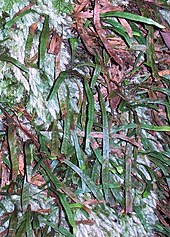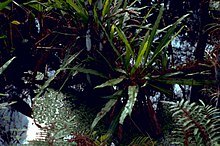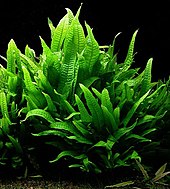Polypodiaceae
| Polypodiaceae | |
|---|---|

| |
| Pleopeltis polypodioides fronds on an oak limb | |
| Scientific classification | |
| Kingdom: | Plantae |
| Clade: | Tracheophytes |
| Division: | Polypodiophyta |
| Class: | Polypodiopsida |
| Order: | Polypodiales |
| Suborder: | Polypodiineae |
| Family: | Polypodiaceae |
| Subfamilies and genera | |
|
See text. | |
| Synonyms | |
| |
Polypodiaceae is a family of ferns. In the Pteridophyte Phylogeny Group classification of 2016 (PPG I), the family includes around 65 genera and an estimated 1,650 species and is placed in the order Polypodiales, suborder Polypodiineae.[1] A broader circumscription has also been used, in which the family includes other families kept separate in PPG I. Nearly all species are epiphytes, but some are terrestrial.[2]
Description[]
Stems of Polypodiaceae range from erect to long-creeping. The fronds are entire, pinnatifid, or variously forked or pinnate. The petioles lack stipules. The scaly rhizomes are generally creeping in nature. Polypodiaceae species are found in wet climates, most commonly in rain forests. In temperate zones, most species tend to be epiphytic or epipetric.[2]
Notable examples of ferns in this family include the resurrection fern (Pleopeltis polypodioides) and the golden serpent fern (Phlebodium aureum).[2]
Taxonomy[]
Two distinct circumscriptions of the family are in use. The Pteridophyte Phylogeny Group classification of 2016 (PPG I) uses a circumscription of Polypodiaceae in which the family is placed in the suborder Polypodiineae (eupolypods I), along with eight other families. The relationship between the families is shown in the consensus cladogram below.[1]
| Polypodiineae (eupolypods I) |
| ||||||||||||||||||||||||||||||||||||||||||||||||
An alternative approach treats the suborder Polypodiineae as the family Polypodiaceae sensu lato, and reduces the families to subfamilies, so that the Polypodiaceae sensu stricto becomes the subfamily Polypodioideae.[3] The broader circumscription is used by Plants of the World Online, as of August 2019; for example, the Dryopteridaceae, shown above as a separate family, is included in its Polypodiaceae.[4] The broadly defined Polypodiaceae has been described as an "unwieldy megafamily".[5]
Subfamilies[]
Molecular phylogenetic analysis has led to the division of the Polypodiaceae into six subfamilies, and to the inclusion of genera that have at various times been placed in other families, including the Drynariaceae, Grammitidaceae, Gymnogrammitidaceae, Loxogrammaceae, Platyceriaceae, and Pleurisoriopsidaceae.[1][6] The following cladogram shows a possible phylogenetic relationship between the subfamilies based on an analysis published in 2008; at the time, Grammitidoideae was not separated from Polypodioideae.[7]
| Polypodiaceae |
| ||||||||||||||||||||||||
The subfamilies are treated as tribes in other systems. Mabberley, in 2008, treated all of Polypodiaceae except for the Platycerioideae (Platycerium and Pyrrosia) and the grammitid ferns, which he placed in Grammitidaceae, as the subfamily Polypodioideae, which he then divided into six tribes, four of which correspond to PPG I subfamilies (Drynarieae, Loxogrammeae, Microsoreae and Polypodieae) and others of which have been submerged (Selligueeae, now within Drynarioideae, and Lepisoreae, now within Microsoroideae).[8] Other systems also treat the subfamilies as tribes.[3] The equivalence is shown in the following table.
| PPG I[1] | Christenhusz & Chase (2014)[3] |
|---|---|
| Family Polypodiaceae J.Presl & C.Presl | Subfamily Polypodioideae B.K.Nayar |
| Subfamily Loxogrammoideae H.Schneid. | Tribe Loxogrammeae R.M.Tryon & A.F.Tryon |
| Subfamily Platycerioideae B.K.Nayar | Tribe Platycerieae Christenh. |
| Subfamily Drynarioideae Crabbe, Jermy & Mickel | Tribe Drynarieae Chandra |
| Subfamily Microsoroideae B.K.Nayar | Tribe Microsoreae V.N.Tu |
| Subfamily Polypodioideae Sweet | Tribe Polypodieae Hook. & Lindl. ex Duby |
| Subfamily Grammitidoideae Parris & Sundue |
Genera[]
In the list that follows, the taxa shown with the "(=)" prefix are considered to be synonyms for the accepted subfamily name that they follow. However, this does not necessarily imply that the subfamily contains all of the synonym's previous genera.[1][6]
- Subfamily Drynarioideae Crabbe, Jermy & Mickel
- (=) tribe Drynarieae Subh.Chandra
- (=) tribe Selligueeae (author?)[8]
- (=) family Drynariaceae Ching
- Combines drynarioid and selligueoid ferns
- Aglaomorpha Schott
- Arthromeris (T.Moore) J.Sm.
- Gymnogrammitis Griff.
- Paraselliguea Hovenkamp
- Polypodiopteris C.F.Reed
- Selliguea Bory

- Subfamily Grammitidoideae Parris & Sundue
- (includes family Grammitidaceae)
- Acrosorus Copel.
- Adenophorus Gaudich.
- Alansmia M.Kessler, Moguel, Sundue & Labiak
- Archigrammitis Parris
- Sundue
- Calymmodon C.Presl
- Ceradenia L.E.Bishop
- Parris
- Cochlidium Kaulf. (including Xiphopteris)
- Ctenopterella Parris
- Dasygrammitis Parris
- Enterosora Baker
- Sundue & Labiak
- Grammitis Sw.
- Lellingeria A.R.Sm. & R.C.Moran
- Leucotrichum Labiak
- J.Sm.
- M.T.Murillo & A.R.Sm.
- Melpomene A.R.Sm. & R.C.Moran
- Micropolypodium Hayata
- R.Y.Hirai & J.Prado
- Mycopteris Sundue
- Parris
- Copel.
- C.Presl (incl. Ctenopteris)
- Parris
- Alderw. (incl. Nematopteris)
- Labiak
- Terpsichore A.R.Sm.
- (T.Moore) Parris
- (E.Fourn.) Parris
- Parris
- Zygophlebia L.E.Bishop

- Subfamily Loxogrammoideae H.Schneid.
- (=) tribe Loxogrammeae R.M.Tryon & A.F.Tryon
- (=) family Loxogrammaceae Ching ex Pic.Serm.
- Lacks sclerenchyma (supporting tissue) in plant body, except in the roots.[8]
- Dictymia J.Sm.
- Loxogramme (Blume) C.Presl

- Subfamily Microsoroideae B.K.Nayar (as "Microsorioideae")
- (=) tribe Microsoreae V.N.Tu
- Goniophlebium (Blume) C.Presl
- Lecanopteris Reinw. ex Blume
- Lemmaphyllum C.Presl
- Lepidomicrosorium Ching & K.H.Shing
- Lepisorus (J.Sm.) Ching
- Leptochilus Kaulf. (including Kontumia)
- Microsorum Link (including Dendroconche, Kaulinia)
- Neocheiropteris Christ.
- Neolepisorus Ching
- Paragramma (Blume) T.Moore
- Thylacopteris Kunze ex J.Sm.
- Tricholepidium Ching
- In 2019, based on a molecular phylogenetic study, Dendroconche was removed from synonymy with Microsorum and two additional genera were created, adding three genera to the subfamily:[9]
- Bosmania Testo
- Dendroconche Copel.
- Zealandia Testo

- Subfamily Platycerioideae B.K.Nayar
- (=) family Platyceriaceae Ching
- Fronds with stellate hairs (star-shaped, radiating from center).[8]
- Platycerium Desv.
- Pyrrosia Mirb.
- Subfamily Polypodioideae Sweet
- (=) tribe Polypodieae Hooker & Lindley ex Duby (sensu Mabberley 2008)
- Campyloneurum C.Presl
- Microgramma C.Presl
- Niphidium J.Sm.
- Pecluma M.G.Price.
- Phlebodium (R.Br.) J.Sm.
- Pleopeltis Humb. & Bonpl. ex Willd.
- Pleurosoriopsis Fomin
- Polypodium L. Perhaps
- Serpocaulon A.R.Sm.
- Subfamily placement uncertain:
- C.Presl
See also[]
References[]
- ^ Jump up to: a b c d e PPG I (2016). "A community-derived classification for extant lycophytes and ferns". Journal of Systematics and Evolution. 54 (6): 563–603. doi:10.1111/jse.12229. S2CID 39980610.
- ^ Jump up to: a b c Panigrahi, G. & Patnaik, S.N. (1961). "Cytology of Some Genera of Polypodiaceae in Eastern India". Nature. 191 (4794): 1207–1208. doi:10.1038/1911207a0. S2CID 4177788.
- ^ Jump up to: a b c Christenhusz, Maarten J.M. & Chase, Mark W. (2014). "Trends and concepts in fern classification". Annals of Botany. 113 (9): 571–594. doi:10.1093/aob/mct299. PMC 3936591. PMID 24532607.
- ^ "Dryopteridaceae Herter". Plants of the World Online. Royal Botanic Gardens, Kew. Retrieved 2019-08-02.
- ^ Sundue, Michael A.; Parris, Barbara S.; Ranker, Tom A.; Smith, Alan R.; Fujimoto, Erin L.; Zamora-Crosby, Delia; Morden, Clifford W.; Chiou, Wen-Liang; Chen, Cheng-Wei; Rouhan, Germinal; Hirai, Regina Y. & Prado, Jefferson (2014). "Global phylogeny and biogeography of grammitid ferns (Polypodiaceae)". Molecular Phylogenetics and Evolution. 81: 195–206. doi:10.1016/j.ympev.2014.08.017. PMID 25173566.
- ^ Jump up to: a b Christenhusz, Maarten; Zhang, Xian-Chun & Schneider, Harald (2011). "A linear sequence of extant families and genera of lycophytes and ferns". Phytotaxa. 19: 7–54. doi:10.11646/phytotaxa.19.1.2. Retrieved 2013-08-11.
- ^ Schuettpelz, Eric & Pryer, Kathleen M. (2008). "Fern phylogeny" (PDF). In Ranker, Tom A. & Haufler, Christopher H. (eds.). Biology and Evolution of Ferns and Lycophytes. Cambridge University Press. Retrieved 2019-08-02.
- ^ Jump up to: a b c d Mabberley, D.J. (2008). Mabberley's plant-book: a portable dictionary of plants, their classification and uses. Cambridge University Press. p. 690. ISBN 978-0-521-82071-4.
- ^ Testo, Weston L.; Field, Ashley R.; Sessa, Emily B. & Sundue, Michael (2019). "Phylogenetic and Morphological Analyses Support the Resurrection of Dendroconche and the Recognition of Two New Genera in Polypodiaceae Subfamily Microsoroideae" (PDF). Systematic Botany. 44 (4): 737–752. doi:10.1600/036364419X15650157948607. S2CID 208176686. Retrieved 2020-02-11.
External links[]
| Wikimedia Commons has media related to Polypodiaceae. |
| Wikispecies has information related to Polypodiaceae . |
- Polypodiaceae
- Fern families
- Epiphytes
- Taxa named by Carl Borivoj Presl

